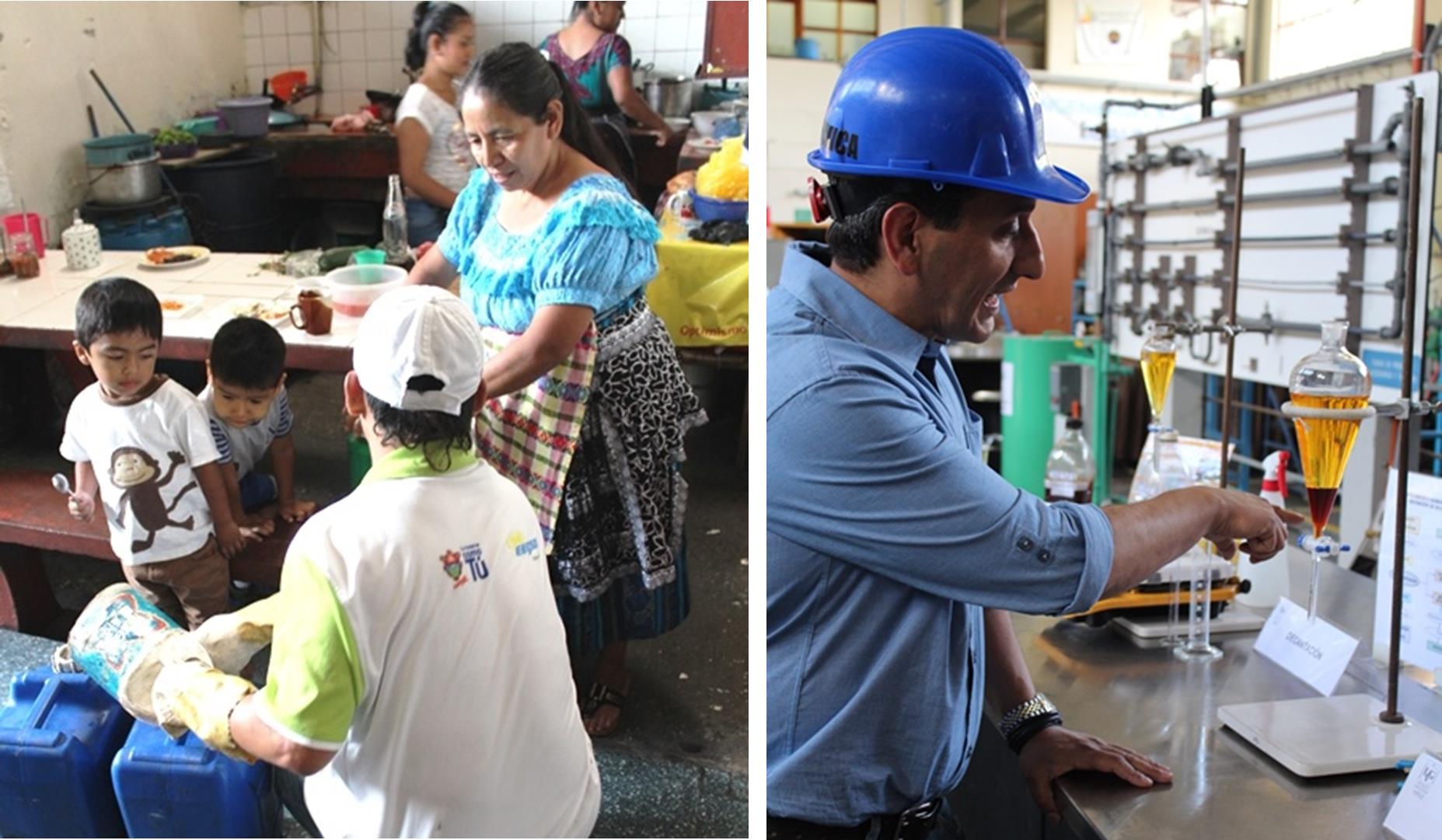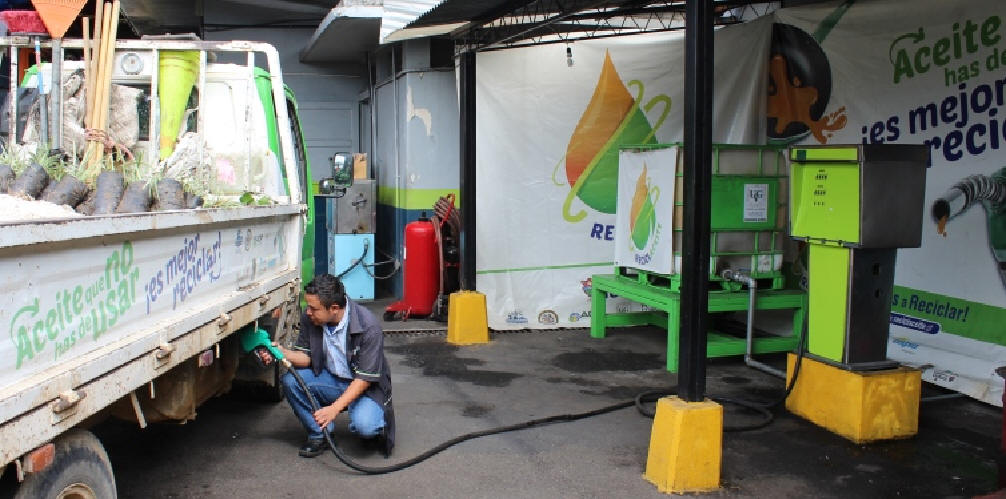|
|
Biodiesel from
Recycled Cooking Oil!
|
|
|

In Guatemala City, a small pilot project to produce biodiesel from recycled cooking
oil has shown so much potential that its organizers are hoping to scale it up to
help power a whole fleet of city vehicles—with clear benefits for the air and water.
|
How it works
At the Chicharronería “El Mañanero,” a bustling eatery located near La Palmita market in Guatemala City, the specialty of the house is deep-fried pork cracklings tucked into tortillas with guacamole, diced radishes, jalapeño peppers, and lemon. All that sizzling pork adds up to a lot of cooking oil, which used to go straight down the drain. Now it goes into 5-gallon plastic containers instead, and eventually makes its way into a gas tank, in the form of biodiesel.
Siomara Segura García, who owns the restaurant, was happy to find an environmentally friendly way to dispose of the waste oil—especially after a disaster last year in which the drainage system at El Mañanero became clogged and she had to shut down for three days. When she heard about a pilot project that would give her the chance to recycle instead, she jumped at the chance to participate.
“It was such a nice project that it caught my interest,” she said. “We’re helping the environment. We’re helping generations to come.”
Segura García is one of about 400 small-business owners at six of Guatemala City’s municipal markets who participated in the project, called Reciclaceite (a combination of the words for “recycle” and “oil” in Spanish).
About the Project
The project received a $50,000 grant under an initiative called
Sustainable Communities in Central America and the Caribbean. The program—funded by the U.S. Department of State and run by the Organization of American States (OAS), through the Energy and Climate Partnership of the Americas (ECPA)—has awarded a total of $1 million in small grants to support 22 projects in different countries.
Reciclaceite brought together several
key players.
The oil recycling project also had a strong social component. Two young men participating in a city employment program for at-risk youth were hired to collect the oil from the market cooks, making their rounds in a pickup featuring the city’s trademark bright green and plastered with messages about the importance of recycling oil. (The project included a logo design and messaging contest.)
.jpg) Another element of the project’s success has been the buy-in from the many owners of little market eateries who were willing to donate their used oil, according to Marta Ximénez de Rivera, who coordinates the energy division at Fundación Solar and advises the organization’s board on energy matters. “People have to be involved. If not, it’s not sustainable,”
...
“this is a pilot project that we want to transform
into a reality that will benefit the city on a
larger scale,” she said. The idea is to start with a
small, modular plant that can be expanded as the oil
collection network grows. Another element of the project’s success has been the buy-in from the many owners of little market eateries who were willing to donate their used oil, according to Marta Ximénez de Rivera, who coordinates the energy division at Fundación Solar and advises the organization’s board on energy matters. “People have to be involved. If not, it’s not sustainable,”
...
“this is a pilot project that we want to transform
into a reality that will benefit the city on a
larger scale,” she said. The idea is to start with a
small, modular plant that can be expanded as the oil
collection network grows.
Biodiesel uses
 For the time being, the used cooking oil being
collected from the markets is processed and blended
with regular diesel to provide enough fuel to
operate six vehicles—four from the city’s parks
department and two from the electric utility. They
run on a mix of one-fourth biodiesel to
three-fourths regular diesel, which cuts the
vehicles’ emissions by 70 percent and represents the
optimal return on investment, according to Ximénez
de Rivera. Engines do not have to be modified to use
this type of blend. For the time being, the used cooking oil being
collected from the markets is processed and blended
with regular diesel to provide enough fuel to
operate six vehicles—four from the city’s parks
department and two from the electric utility. They
run on a mix of one-fourth biodiesel to
three-fourths regular diesel, which cuts the
vehicles’ emissions by 70 percent and represents the
optimal return on investment, according to Ximénez
de Rivera. Engines do not have to be modified to use
this type of blend.
The waste oil is processed in a biodiesel pilot
plant in a laboratory that is part of the UVG
Chemical Engineering Department. The partnership
with this “green university” ensured a high standard
of quality and enhanced the project’s credibility,
Ximénez de Rivera said.
About Biodiesel
Biodiesel
can be produced from vegetable oil or animal oils
and fats. When waste oils from the food industry are
used, the conversion process begins by filtering the
oil and letting it settle; alcohol and a catalyst
are then added to break down the oil into smaller
molecules. Additional steps remove any water and
byproducts such as soaps and glycerin. The end
product is tested for such characteristics as
purity, viscosity, density, and acidity, to make
sure it meets high standards, according to Cristián
Rossi Sosa, who heads the UVG laboratory.
The UVG plant can process 200 liters (around 53
gallons) at a time, and the conversion from waste
oil to biofuel takes three to four hours. The
university processes waste oil from other sources as
well, so it can handle only a limited amount of oil
collected from the markets.
But even on this small scale, the project is
beneficial, according to Gamaliel Zambrano, director
of the university’s Center for Industrial Processes.
First, he said, reducing the amount of cooking oil
that is discarded into the sewer system
significantly helps reduce groundwater
contamination. And using biodiesel cuts air
pollution. The city government is setting a strong,
positive example, Zambrano said. “It’s a drop that
contributes, and contributes a lot,” he said. “That
example can actually be replicated.”
» Original source and
further information here
|
|
|
|